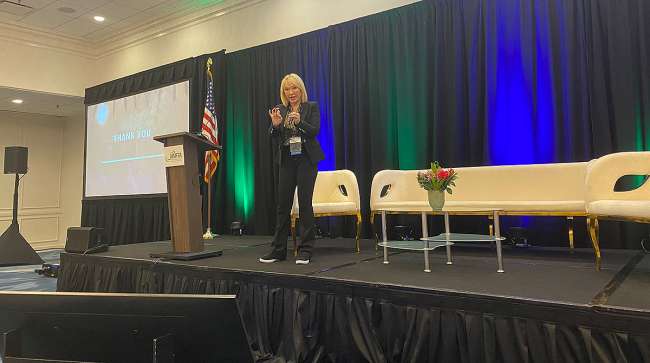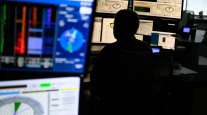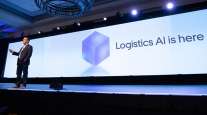Staff Reporter
AI, COVID Created a New Normal for the Supply Chain

[Stay on top of transportation news: Get TTNews in your inbox.]
HOUSTON — A supply chain expert said the emergence of powerful, open-source artificial intelligence arriving just as the global economy was emerging from the coronavirus pandemic created turbulent economic conditions that are reshaping how companies are run.
“A year ago — right about this time — I thought, ‘We’re coming out of it,’ ” said Nada Sanders, a professor of supply chain management at the Northeastern University D’Amore-McKim School of Business, during an Oct. 24 presentation at the National Motor Freight Traffic Association Digital Solutions Conference. “We’re done with the pandemic, businesses are struggling — a lot of them were managing cash pretty carefully — but we’re floating, we’re coming out. And then comes November 30th and out comes OpenAI with ChatGPT, and boom, there was yet another thing that very quickly changed everything.”
Sanders said the supply chain has entered a “new normal” in the wake of these intersecting circumstances. In particular, she noted that the supply chain has become very unpredictable, rendering irrelevant many assumptive parameters that businesses historically used to navigate future expectations.
But even as technology has become more important amid these changes, so, too, have human workers. She pointed out, for example, that humans are simply better suited for certain things; people have experience, judgment and knowledge of how to handle a situation that stretches beyond algorithms that propel AI capabilities.
But rather than rely on one over the other, Sanders said, forward-thinking companies can integrate both in a complementary way.
“The integration of people and technology,” she said. “We found that this was really what was making leading companies tick, at the end of 2019. And then we all know what happened shortly thereafter. The pandemic happened.”
But that model, she said, can help companies navigate the post-pandemic world.
“Most businesses are designed for what we call the blue sky environment — blue sky meaning, ‘OK, this is how we’re going to run the business; this is how things go, and then when really bad things happen, we’re going to invoke contingency plans, we’re going to clear it up, and then we’re back to blue sky days.’ Well, I can tell you that we are in this period — it’s not coming back. We’re just cascading from one event to another — more events, more fires.”
This turbulence is why, she said, companies can find some help with AI-based systems.
“We need the technology, but remember that there are certain assumptive parameters and in a volatile world — and we’re in a volatile world, no question — those assumptive parameters rapidly change.”
Complicating matters for businesses are broader geopolitical factors that shape the domestic economy. In years past, businesses might confront disruptions such as bad weather that could be resolved within a few weeks. Now, she noted, the economy is dealing with multiple disruptions occurring back-to-back, which makes it difficult for business conditions to stabilize.
Want more news? Listen to today's daily briefing above or go here for more info
“[The business community] doesn’t have time to recover. They don’t have time to go back to baseline, and so there’s no end in sight,” Sanders said. “I mean, right now we’ve got droughts in the Panama Canal. We’ve got all kinds of things that are impacting and cascading — shipments, labor issues. There’s a cascade of things and a collision of all these things that have to do with this post-pandemic new normal. I’m monitoring them constantly and watching, ‘What is the Fed going to do, what are we going to do, how are we going to play it out?’ ”
Sanders noted that, on the ground level, individuals must realize how these various factors affect their daily lives.
“So much of the world still hasn’t really gotten it, or maybe they’ve forgotten,” she said. “I’ll be asked about things like, ‘Why are food prices so high again?’ and I’m saying, ‘Well, have you noticed the price of fuel and energy and transportation?’ That connection still hasn’t been made by the average person, the average consumer.”




